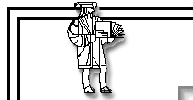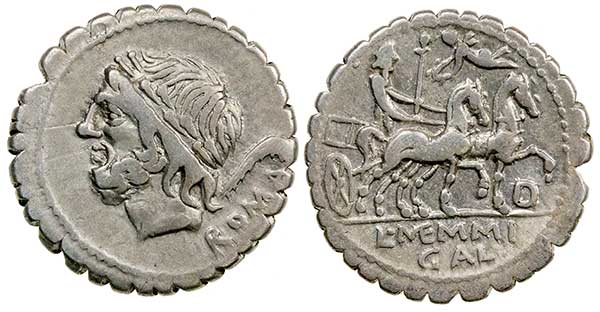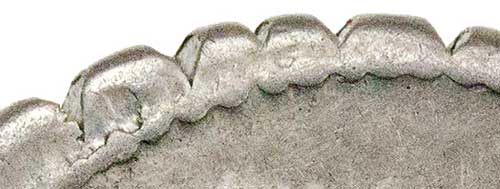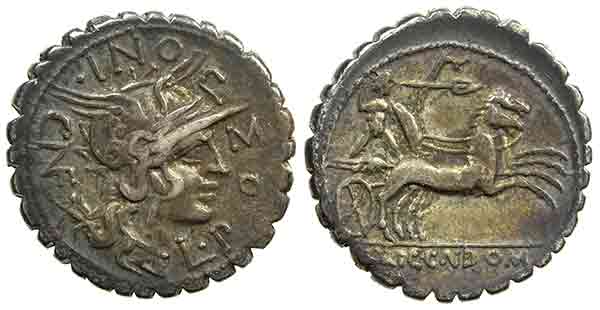 |
 |
|
Roman Serrated Denarii
This Roman Republican denarius was issued by L. Memmius Galeria in about 106 BC. The obverse depicts the right facing head of Saturn with ROMA behind. The reverse depicts Cupid flying over a biga driven right by Saturn, with "L. MEMMI GAL" in two lines below. The edge of this coin is serrated. Serrated denarii are unique to the Roman Republic with most issued from the late 2nd to early 1st century BC. While relatively common, after more than 200 years numismatists have agreed on why some types of Republican denarii are serrated others are not, even if issued simultaneously. We do not see any types with both serrated and non-serrated examples. While a rare example could exist as a mint error, I have never encountered one. Each type is either serrated or not. I have looked at many examples and I can make the following observations. 
The depth and spacing of the serrations are inconsistent as are their positions when two example of the same type are compared. This shows each serration was individually cut, probably with a hammer and chisel. There are metal ridges inside of many of the cuts, parallel to the coin's surface, even on mint state examples. A chisel cut to the edge of a coin would raise ridges perpendicular to the surface, yet these have been pushed flat parallel to the surface inside the cuts. This is consistent with the ridges being raised prior to striking and pushed flat on striking. Had they been post striking they would still be perpendicular to the edge, and highly worn in circulation. Thus the serrations are part of the original minting process. With 33 individual serrations, not unusual for one of these, it would have been very labor intensive to serrate the several hundred thousand coins of each type that would have been issued (possibly a million for some issues). It seems unlikely this would be done without a specific need to do so. I know of two competing theories for that need. The first is an anti-counterfeiting measure making the minting of counterfeit fourrée (silver wrapped base metal core) denarii difficult. Wrapping silver foil around an already serrated copper core would cover the serrations so that they would not show. Cutting serrations in a copper core already wrapped in silver would expose the copper core defeating the purpose. Thus serrating denarii would be an effective anti-counterfeiting method at a time many fouree denarii were appearing, although a few serrated fourrée are known, they are very rare. The problem with this theory is large numbers of non-serrated denarii were issued simultaneously with serrated ones and there are long periods during which only non-serrated denarii were issued. If it were to stop counterfeiting why were most denarii issued without serrations. The second theory is serrations pre-exposed the solid silver making such coins more readily acceptable to as payment to non-Roman people less used to Roman denarii who might there wise have wanted to test cut every coin before accepting a large payment of many denarii. I believe the time line of their issue suggests this is the correct theory. The first serrated denarii were struck anonymously about 209 to 208 BC, and appear to have been minted in Sicily (thank you to Kenneth L. Friedman for pointing out this early type to me). Rome was involved in the second Punic war and the first Macedonian War, both of which would have involved large payments to foreign people in North Africa, Sicily and Macedonia. At the time Rome used mostly bronze coins so denarii were not yet a significant part of the local Roman economy, with most of these early denarii issued for foreign payments. 
87 years then passed with only smooth edge denarii struck. In 121 BC Roman capturing territory from the Allobroges and Arverni tribes in Gaul, where in 118 BC they established their first colony in Gaul. The city of Narbo was build as their regional seat of government and in an unusual practice for the time they established new mint at Narbo from which came an immense issue of serrated denarii depicting the head of Roma on the obverse, a Celtic warrior in his chariot on the reverse, which several variations of inscriptions naming Roman government and military officials involved the conquest and colonial government. Constructing a new city required a lot of coins to pay local labor and suppliers. For over 90 years only smooth edge denarii has been struck, mostly at Rome then shipped long distanced to where they were needed. They could easily have supplied Narbo that way, so why set up a new mint and issue labor intensive serrated denarii. Local Celtic people would have been aware the Romans had a problem with circulating fourrée counterfeits, so would have had miss-trust in Roman silver. Presented with smooth edge coins they might have insisted on test cutting each coin to confirm solid silver before accepting them, making the payment process difficult. Minting serrated coins locally with Celtic labor would have created confidence in the coin. Depicting a Celtic warrior in his chariot on them would not have hurt either. Keep in mind that Narbo was a new Roman city but the local population from whom much labor would have been drawn were Celts and the Roman had to learn to get along with them. The Narbo serrated denarii were only issued for about one year ceasing in 118 BC, probably as the building phase was completed. The only silver denarii issued for the next twelve years were smooth edge mostly struck at Rome. Serrated denarii were again issued in 106 to 105 BC by four moneyers at Rome, corresponding with the end of the Jugurthine War in North Africa where again payment to non-Roman people would be required. Then 22 passed with only smooth edge denarii until the moneyer Q. Antonius Balbinus again issued them in 83 BC after which there were a number of issues down to 79 BC. This corresponded with the end of the first Mithradatic and the Sertorian wars, both of involving foreign troops. After 79 BC serrated denarii were issued only very sporadically then the last issue of them was struck by L. Roscius Fabatus between 64 and 62 BC (the exact year is uncertain). This corresponded with the 2nd and 3rd Mithradatic wars. Other wars were fought with no associated serrated denarii but many of those were internal civil wars without need to make payments for foreign people, and for others we don't know for sure if payments to foreign troops were involved or not. More in depth research might turn more of a pattern, but the best pattern I currently see is that all serrated denarii appear to correspond with a need to make payments to non-Roman peoples who might not have trusted the coins. By 62 BC the Romans had subjugated most of the Mediterranean basin so people now remained outside of their influence that they might make payments too, so would not already be using Roman coins. The need for fourrée for that purpose would have ended. In that I believe we see their primary purpose. 
Copyright © 2016 R & T Enterprises Ltd. |